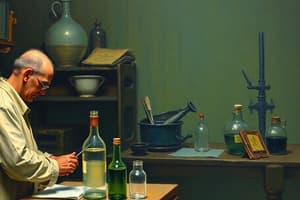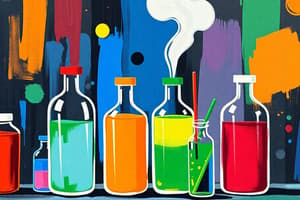Podcast
Questions and Answers
What should you do immediately after removing a reagent from its bottle?
What should you do immediately after removing a reagent from its bottle?
- Leave the cap off until you're finished using it
- Pipet directly from the reagent bottle
- Put the cap back on the reagent bottle (correct)
- Set the stopper on the tabletop
What is the primary method of treating chemical burns?
What is the primary method of treating chemical burns?
- Cover the burn with a dry dressing without washing
- Apply ice directly to the burn area
- Wash immediately with large quantities of water (correct)
- Apply lotion to the burn area right away
Which action is NOT recommended for handling glassware in the lab?
Which action is NOT recommended for handling glassware in the lab?
- Dispose of solid wastes in the trash bin
- Wash glassware with detergent and water
- Leave glassware uncleaned until the next lab session (correct)
- Use distilled water for final rinsing of glassware
What is the primary purpose of a chemical laboratory according to the defined standards?
What is the primary purpose of a chemical laboratory according to the defined standards?
What should you do if acid has been swallowed?
What should you do if acid has been swallowed?
What steps should be taken for a chemical injury to the eye caused by an acid?
What steps should be taken for a chemical injury to the eye caused by an acid?
What is the recommended method for disposing of solid wastes in the laboratory?
What is the recommended method for disposing of solid wastes in the laboratory?
What is one of the key factors in achieving efficient chemical laboratory management?
What is one of the key factors in achieving efficient chemical laboratory management?
What should you do before leaving the laboratory?
What should you do before leaving the laboratory?
Why is chemical laboratory management important?
Why is chemical laboratory management important?
When dealing with heat burns, what is the immediate action to take?
When dealing with heat burns, what is the immediate action to take?
Which safety measure is necessary when heating liquids in a test tube?
Which safety measure is necessary when heating liquids in a test tube?
Which standard requires a laboratory space of at least 1 sqm per student?
Which standard requires a laboratory space of at least 1 sqm per student?
When should you use personal protective equipment (PPE) in the lab?
When should you use personal protective equipment (PPE) in the lab?
What type of hazard is classified under 'Toxic' in the GHS?
What type of hazard is classified under 'Toxic' in the GHS?
What is a primary consequence of neglecting safety in a laboratory setting?
What is a primary consequence of neglecting safety in a laboratory setting?
What should you do if you have excess chemicals after an experiment?
What should you do if you have excess chemicals after an experiment?
What is one safety provision that must be included in a well-managed laboratory?
What is one safety provision that must be included in a well-managed laboratory?
What does the Globally Harmonized System (GHS) focus on?
What does the Globally Harmonized System (GHS) focus on?
What is the primary use of a test tube rack?
What is the primary use of a test tube rack?
Why is it important to know the locations of emergency equipment in the lab?
Why is it important to know the locations of emergency equipment in the lab?
What is the correct procedure for mixing concentrated acids or bases?
What is the correct procedure for mixing concentrated acids or bases?
What should you do if you break something made of glass in the lab?
What should you do if you break something made of glass in the lab?
What is a common mistake students make regarding the handling of gloves in the lab?
What is a common mistake students make regarding the handling of gloves in the lab?
What type of safety information is included in a Materials Safety Data Sheet (MSDS)?
What type of safety information is included in a Materials Safety Data Sheet (MSDS)?
Which piece of equipment is specifically used to handle hot crucibles?
Which piece of equipment is specifically used to handle hot crucibles?
What is the function of a mortar and pestle in a laboratory setting?
What is the function of a mortar and pestle in a laboratory setting?
What distinguishes a graduated cylinder from other glassware?
What distinguishes a graduated cylinder from other glassware?
Which of the following describes the purpose of a funnel in laboratory procedures?
Which of the following describes the purpose of a funnel in laboratory procedures?
Which of the following best describes the purpose of a glass rod in the lab?
Which of the following best describes the purpose of a glass rod in the lab?
What is a key characteristic of a filter paper cone during filtration?
What is a key characteristic of a filter paper cone during filtration?
For what purpose is a volumetric flask primarily used?
For what purpose is a volumetric flask primarily used?
What is the main characteristic of an Erlenmeyer flask?
What is the main characteristic of an Erlenmeyer flask?
What is the primary use of a watch glass in a laboratory setting?
What is the primary use of a watch glass in a laboratory setting?
What role does wire gauze play in laboratory settings?
What role does wire gauze play in laboratory settings?
What is the function of a desiccator in the laboratory?
What is the function of a desiccator in the laboratory?
Which piece of laboratory equipment is specifically designed to hold glassware during experiments?
Which piece of laboratory equipment is specifically designed to hold glassware during experiments?
Which equipment is best suited for dispersing small volumes of liquids, such as in titration?
Which equipment is best suited for dispersing small volumes of liquids, such as in titration?
What is the recommended approach to prevent bumping when heating a liquid in a beaker?
What is the recommended approach to prevent bumping when heating a liquid in a beaker?
In which scenario should no heating be applied to the measuring apparatus?
In which scenario should no heating be applied to the measuring apparatus?
Flashcards are hidden until you start studying
Study Notes
Chemical Laboratories
- Chemical laboratories are facilities where chemical analysis and synthesis take place.
- Laboratories require specific equipment for sample preparation and analysis.
- The Chemistry Law of the Philippines (RA 10657) defines a chemical laboratory based on its activities.
Chemical Laboratory Management
- Safety is paramount in chemical laboratories to protect individuals and the surrounding community.
- Quality assurance is essential to ensure high-quality products and services.
Laboratory Safety
- Accidents can happen due to neglecting safety practices.
- Examples include lab explosions, accidental poisoning, and fires.
Key Factors for Effective Chemical Laboratory Management
- Laboratories must adhere to acceptable standards such as RA 6541 (National Building Code of the Philippines) and PD 856 (Code of Sanitation of the Philippines).
- Adequate space, lighting, ventilation, and non-slip floors are essential for a safe lab environment.
- Proper enclosure of gas cylinders outside the lab is crucial.
Understanding Chemicals
- The Globally Harmonized System (GHS) standardizes chemical hazard classification and communication.
- Chemical hazard labels indicate flammability, health hazard, reactivity, and special precautions.
- Materials Safety Data Sheets (MSDS) provide detailed information about chemicals, including physical properties, toxicity, and safety procedures.
General Safety Principles
- Wear personal protective equipment (PPE) at all times, including long pants, closed shoes, and tied back hair.
- Remove gloves before touching objects like doorknobs, phones, or keyboards to avoid contamination.
- Know the location of safety equipment like fire extinguishers, first aid kit, eye washes, and showers.
- Never point a test tube towards yourself or others when heating liquids.
- Use boiling chips to prevent bumping when heating liquids in flasks or beakers.
- Keep work areas clean and organized.
- Report all accidents promptly.
- Dispose of broken glass carefully using a dustpan and broom.
- Never return unused chemicals to their original containers.
- Always add acid to water, never water to acid.
- Use fume hoods when working with noxious fumes.
- Avoid putting anything in your mouth while in the lab.
- Use reagents and lab supplies responsibly.
- Dispose of solid wastes properly.
- Replace reagent bottle caps immediately after use.
- Pipet liquids from a beaker, not directly from the reagent bottle.
- Before leaving the lab, ensure your work area is clean and tidy.
First Aid for Common Laboratory Hazards
- Cuts: Wash with soap and water, apply pressure, disinfect, and cover with a waterproof dressing.
- Heat Burns: Immediately immerse the burnt area in cold water and cover with a dry dressing.
- Chemical Burns: Wash with copious amounts of water and neutralize with a suitable chemical. Use sodium bicarbonate for acid burns and boric acid powder for alkaline burns. Seek medical attention.
- Chemical Eye Injury: Flush the eye with large amounts of water. Neutralize with 5% sodium bicarbonate solution (acid) or 5% acetic acid (alkaline). Seek medical attention.
- Poisoning (Swallowing Acid or Alkali): Immediately rinse the mouth thoroughly with water. Neutralize acid with magnesium hydroxide suspension (milk of magnesia) and alkali with lemon juice or 5% acetic acid.
Common Glassware and Apparatus
- Test Tube: A cylindrical glass tube for holding small amounts of chemicals.
- Test Tube Rack: Holds multiple test tubes upright.
- Test Tube Holder: Holds a test tube when it's hot or shouldn't be touched.
- Aspirator: Creates a vacuum using the Venturi effect.
- Crucible: A cup-shaped container for heating chemical compounds at high temperatures.
- Mortar and Pestle: Used to crush solids into smaller pieces or powder for easier dissolving.
- Crucible Tong: Used to lift hot crucibles or other objects.
- Wire Gauze: A mesh sheet placed on a ring stand to support glassware during heating.
- Beaker: Holds liquids or solids and used in reactions, measuring, and heating.
- Erlenmeyer Flask: Used for containing, mixing, heating, cooling, and storing liquids.
- Volumetric Flask: Calibrated to contain a precise volume at a specific temperature.
- Graduated Cylinder: Measures the volume of liquids.
- Funnel: Used to channel liquids or powders into containers with narrow necks.
- Watch Glass: A round, concave glass dish for evaporation, weighing solids, and as a lid for beakers or flasks.
- Glass Rod: Used to mix chemicals and liquids.
- Vials: Flat-bottomed glass containers for holding small amounts of liquids or solids.
- Dropper: Transfers small quantities of liquids.
- Evaporating Dish: Used to evaporate liquids and solutions to produce solids or concentrated solutions.
- Pipette: Measures and transfers small volumes of liquids.
- Burette: A graduated glass tube with a tap for delivering precise volumes of liquids, especially in titrations.
- Ring Stand: Holds glassware during experiments.
- Tripod Stand: Provides a platform to support glassware.
- Muffle Furnace: A heating device that provides precise temperature control.
- Desiccator: An airtight container that maintains a low humidity environment.
Basic Laboratory Techniques
- Heating Solutions in Beakers/Flasks: Place the beaker or flask on a wire gauze supported by a tripod stand. Add boiling chips to prevent bumping. Avoid heating volumetric apparatus, as it can distort the measurements.
- Filtration: Separates solids from liquids by passing the liquid through a porous material. Don't fill the filter paper cone more than two-thirds full.
Studying That Suits You
Use AI to generate personalized quizzes and flashcards to suit your learning preferences.



